A Cosmic Supporting Cast Greek mythology has a gigantic supporting cast to the stars of the legends, the heroes and the gods. There were all sorts of monsters, Titans, and others who appear in the legends at some time. The Titans The Titans were the gods that ruled before the Olympians took over. The Titans who were the 12 children of Gaia and Ouranos were known to be a personification of some part of time, but there were many other Titans as well. Atlas: Atlas was a Titan, but he was a child of Iapetus, not Ouranos. He is known as "endurance" in Greek. It's a good name for the one who holds the Earth on his shoulders. However, the stories differ on how he got his job. After the war between the Titans and the Olympians, he was said (in some stories) to have led a rebellion against Zeus's rule. When the rebellion failed, Zeus's punishment upon Atlas was for Atlas to hold the Earth on his shoulders for all eternity. In other legends, Atlas was simply the god who turned the Earth and made the sky and stars change. In other legends still, he didn't hold the sky, he just guarded the pillars that held the sky. Crius: Crius was the Titan associated with the southern pillar of the world. He was cast into Tartarus with his fellow pillar-gods by Zeus. Coeus: Coeus was the Titan of the northern pillar of the world, which was said to help hold the heavens up. He was commonly associated with heavenly oracles. He along with his brothers were eventually thrown into Tartarus by Zeus. Cronos: Cronos (also spelled Cronus or Kronos) was one of the children of Gaia and Ouranos. He was the god of time, and the king of the Titans. He was the leader of the Titans, and the father of Zeus, Poseidon, Hades, Hera, Hestia, and Demeter. He, with the help of his siblings Crius, Coeus, Iapetus and Hyperion, overthrew his father, Ouranos, and took over the position of ruler of the world. He had recieved a prophecy that one of his children would overthrow him, so he swallowed each of his children when he or she was born. However, Rhea saved Zeus by giving Cronos a rock to swallow instead of Zeus. Zeus was hidden on the island of Crete, until he was old enough to free his siblings. Epimethus: Epimethus was the Titan god of afterthought; an opposite of his brother Prometheus. The two brothers were told to create all the life that now exists. However, Epimethus used all of the skills and talents they were supplied to help animals, so Promethus's humans had nothing to use to defend themselves. Promethus instead stole from the gods to help his creations. The gods punished both brothers for Promethus's crimes. While Promethus was chained and tortured by a bird, Epimethus was given a gift of a beautiful woman, Pandora, as his bride. She came bearing a holding jar, and Epimethus, lacking his brother's foresight, opened it. Trapped within the jar were all sorts of evil daimones (demons) and one good spirit: Elpis, the spirit of hope. Gaia: Gaia was the Titan who was the very Earth personified. She was one of the first two true beings in Greek mythology. After Ouranos imprisioned the Cyclopes and Hekatonkheires, she encouraged her sons to destroy Ouranos. Helios: Helios (also spelled Helius) was the Titan god of the sun. He drove a chariot (the sun) through the sky every day. He was the son of Hyperion, one of Cronos's brothers. Hyperion: Hyperion the Titan ruled the eastern pillar of the world, and was sealed in Tartarus with the other Titan pillar gods by Zeus. However, he ruled the sun before those times, and was the fathers of the lights of the sky, Eos (Dawn), Helios (Sun) and Selene (Moon). Iapetus: Iapetus was the Titan of the western pillar of the world. After Zeus sent him and the other pillar bearers to Tartarus, his son, Atlas, ruled the western pillar. His other famed children are Prometheus and Epimethus. Mnemosyne: Mnemosyne was the Titan goddess of memory. Being a child of Gaia and Ouranos, she was also involved in ruling before the Olympians. She was the mother of the nine Muses, the goddesses of the arts. Oceanus: Oceanus was another of the twelve childeren of Ouranos and Gaia. His Greek name literally translated to "River Ocean." He ruled over the River Okeanos, the river that encircled the Earth and gave all water to it, even including that of the stormclouds. Planets and stars were thought, back then, to rise and sink into the River Okeanos, making Oceanus the god of them, too. His wife was Tethys. Ouranos: Ouranos (also known as Uranus, in both Greek and Roman mythology) was the Titan who was literally the sky. He was the other of the first two true beings in Greek mythology. He was orriginally the king of the world, before he imprisioned the Cyclopes and Hekatonkheires. After this, Gaia encouraged her children to rebel against Ouranos and destroy him. Ouranos was destroyed by Cronos, who received help from his brothers Hyperion, Coeus, Crius and Iapetus. Prometheus: Prometheus was the Titan god of foresight, who loved to sculpt clay, and even scupted the first humans. Prometheus loved to help the creatures he created, even going so far as to steal from the gods. Time and time again, Prometheus would trick the gods to get various things for the people, whether it be food or fire. Eventually, the gods all decided they had had enough of Prometheus's tricks. Zeus took fire away from the humans, but Prometheus quickly returned it. Finally, Zeus chained Prometheus to a boulder (or a stake), where a bird (most likely a vulture or eagle) would peck at Prometheus's liver every day. The Titan had no way to escape his torture until Hercules freed him, many, many years later. Meanwhile, his less capable brother Epithemus was given Pandora and accidentally cursed mankind. Rhea: Rhea was one of the children of Gaia and Ouranos. She was a goddess of motherhood and her name means "ease" or "flow". She was Cronos's wife and the queen of the Titans. She personified the generations passing. Tethys: Tethys was the goddess of freshwater (suitable job for the wife of Oceanus) and her name translates to "mother" or "nurse," most likely because freshwater heals the whole world. She was also said to have cared for (or nursed, in other words) Hera after she was regurgitated by Cronos but before she was full-grown. Potami, Oceanides, and Nephale: These three groups of gods and goddesses all are children of Oceanus and Tethys, and all rule different kinds of water. The Potami are the gods (all males) of rivers, which all stemmed from the River Okeanos. It's actually a very clever mataphor: The rivers were sons of River Okeanos like the Potami were the sons of Oceanus. The Oceanides are all nymphs, exactly three thousand in number, that presided over the different sources of freshwater in the world. Some of them, like Metis or Thyke, were personifications of blessings, like wisdom or fortune. Nemesis was also a Oceanide, balancing out blessings by taking them from those who didn't deserve them. They were considered the "Good Spirits", and tended to be mysterious and hidden. Some of them (at least sixty or so) served various goddesses, like Hera and Artemis. The Nephale were actually a division of the Oceanides. They presided over rain and rainclouds. They were said to carry water to the heavens in pitchers, like the girl in the constellation Aquarius. They were depicted as young women, very pretty and sometimes wearing robes. The Monsters A common element in any mythology is that ordinairy creatures make appearances as sacred, or as gods in disguise. In Greek mythology more than any other, though, unnatural creatures appear, usually savage and dangerous. Argus: Argus was a rare peaceful monster. He was Hera's guard, with about 100 eyes scattered all over his body. Argus was killed by Hermes, but Hera honored Argus for all eternity by putting his eyes into the tail of a peacock, her favorite bird. Ceberus: Ceberus was a three-headed dog that guards the enterance to the underworld, keeping the living out and the dead in. Hercules's 12th task was to bring Ceberus to King Eurystheus. Charybdis and Syclla: These two are usually considered a pair, as they are both savage sea monsters. Charybdis created whirlpools each time it took a breath. Syclla, however, devoured sailors alive. Chimaera: The Chimaera was a creature that had the head and body of a lion, a goat's head growing from its back, and a snake for a tail. It was also the father of the Nemean Lion. Cyclopes: (singular form Cyclops, also spelled Kyklopes) Cyclopes were one-eyed creatures who worked to forge thunderbolts for Zeus. Gorgons: Gorgons are the humanoid creatures with sepents instead of hair. Medusa is the most famous of the Gorgons, though the legends implicate there were at least two more. Hydra: The Hydra was a serpent, or a serpent-like creature. It started out with nine heads, but whenever one was cut off, two more grew in its place. Hercules felled this beast by having one of his allies seal off the stumps of its heads using a torch. Minotaur: The Minotaur was the creature that lived in King Minos's Labrynth. It looked like a bull, stood on two legs, and was insane. In some legends, it would even breathe fire! Sirens: Sirens were island creatures that looked like beautiful women with wings. They would sing so sweetly, they would cause sailors to steer towards, and most likely crash into, their island. Various heroes survived them by plugging their ears as they sailed by the Sirens. Arachne: Arachne (or Arakhne) was a talented weaver, not a monster. She was so talented, she thought she could weave even better than Athena. (The Greek called having this much pride, and thinking oneself better than the gods, hubris.) Naturally, she wanted to prove her skill, and challenged Athena to a weaving contest. They both set to work, and when they were both finished, Athena presented a beautiful tapestry of the gods and goddesses atop Mount Olympus. The legends differ on what Arachne's tapestry showed, but it was extremely insulting to the Olympians. Everyone agreed that Arachne's tapestry was better woven, and Arachne was declared the winner. Athena was so angry, she immediately decided to punish Arachne. Athena turned Arachne to a form where she could weave forever... Arachne was turned into a spider! This was probably a fable (or something like it) to the Greeks, to teach them to not think themselves better than the gods. Arachne's name is the source of the word arachnid, the genetic family that spiders fall under. | 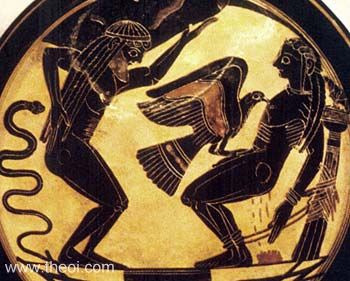 Above: Clay pot depicting Atlas holding the world (left), and Prometheus being attacked by the bird that ate his liver (right). Below: Cronos and Rhea
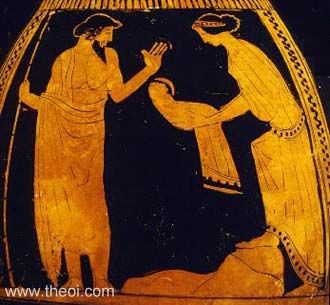 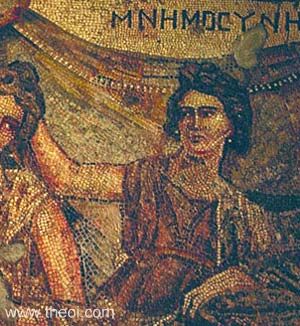 Above: Mnemosyne Below: Oceanus and Tethys 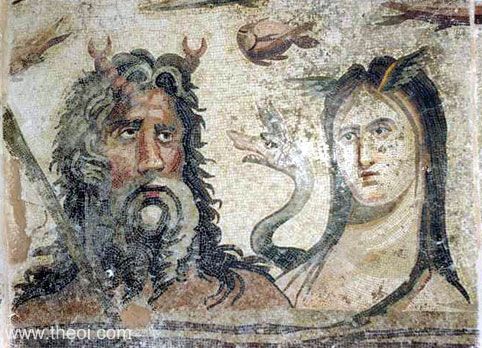 Below: Helios 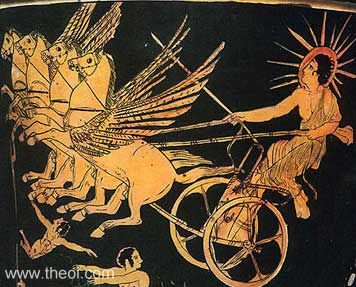  Above: The Hydra Below: The Minotaur 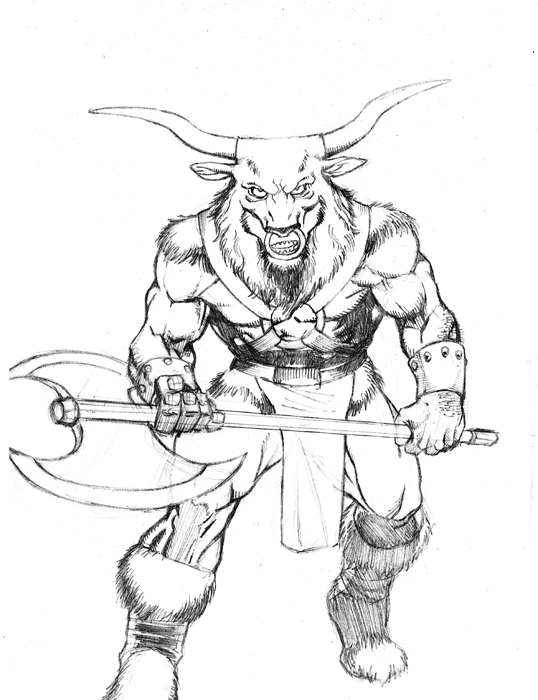 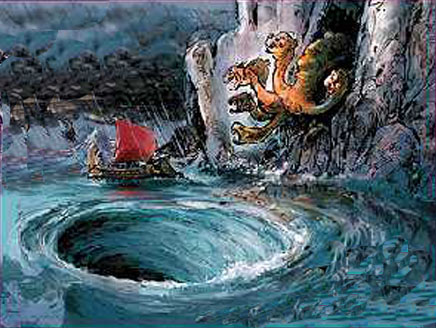 Above:Charybdis and Syclla in their natural enviornment. Charybdis is hidden in the whirlpool, and Syclla is the creature in the cave. Below: Ceberus 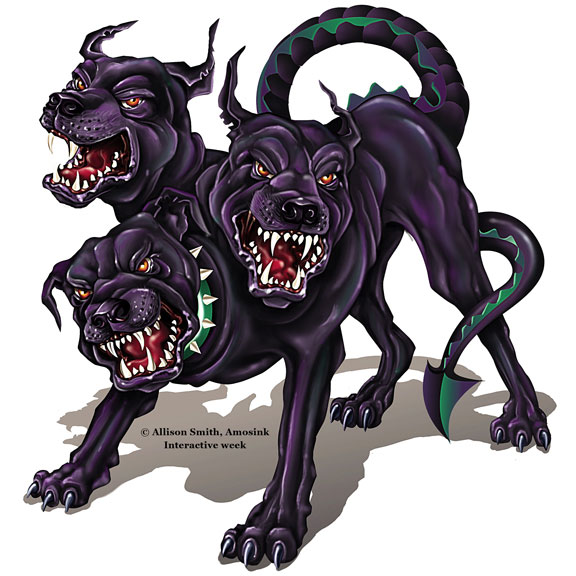 Below: A Siren 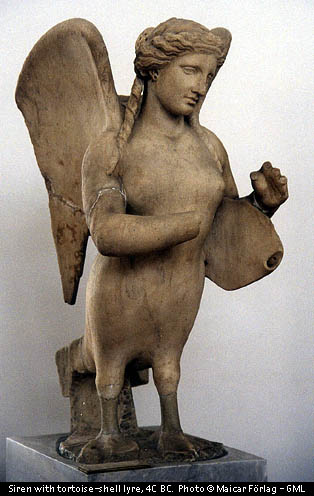 Below: Chimaera 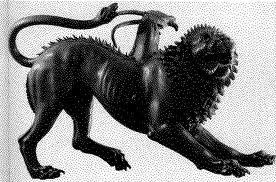 |